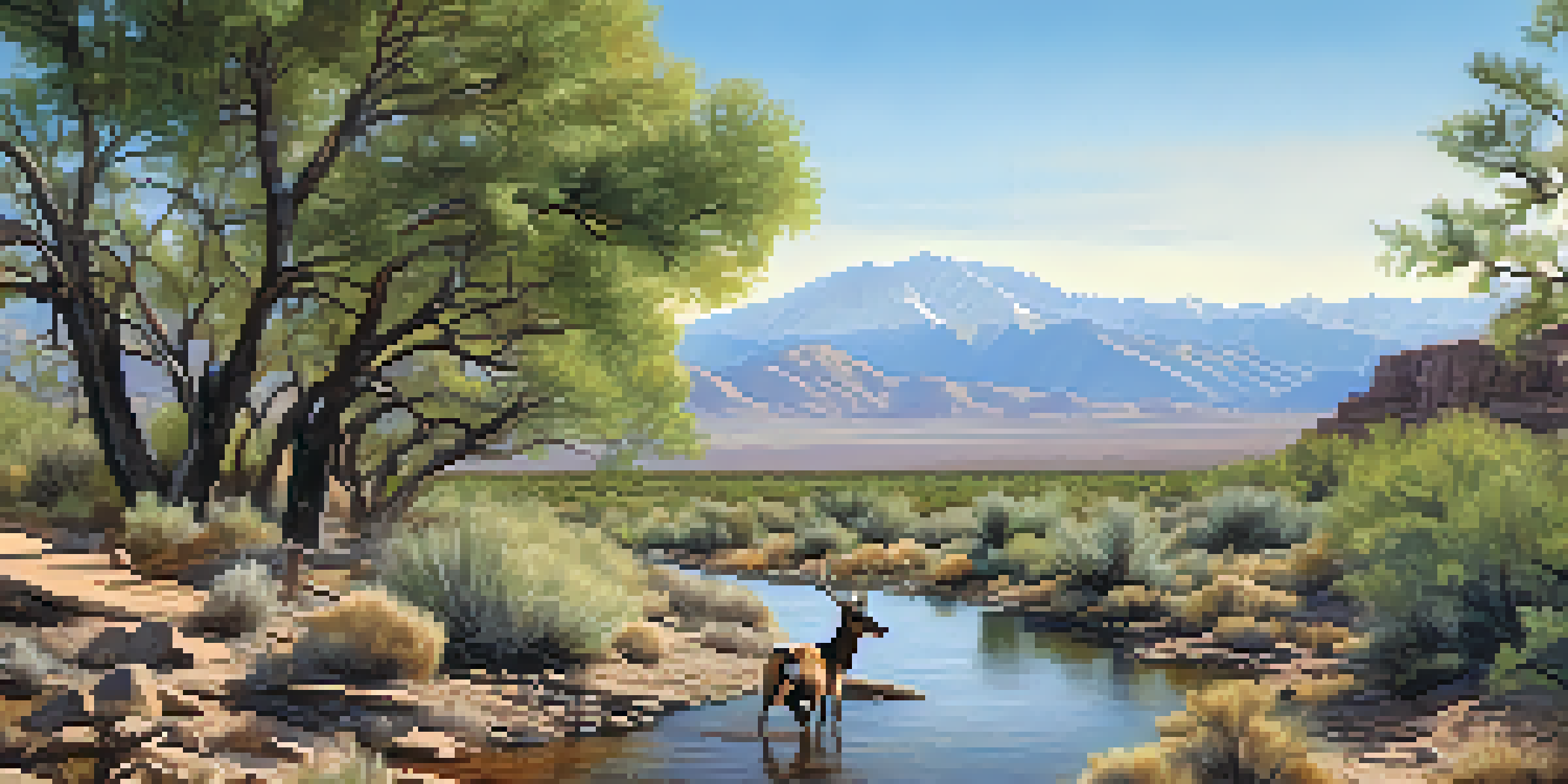Wildlife Corridors: Connecting Habitats in Nevada

What Are Wildlife Corridors and Why Are They Important?
Wildlife corridors are natural or man-made pathways that connect fragmented habitats, allowing animals to move freely between them. Imagine a busy highway where animals are constantly dodging cars—a corridor helps them cross safely. This connectivity is crucial for species survival, as it enables them to find food, mates, and safe places to raise their young.
Conservation is a state of harmony between men and land.
In Nevada, diverse ecosystems like deserts, mountains, and forests are home to various wildlife species. However, urban development, agriculture, and roads have disrupted these habitats, isolating animal populations. Corridors help mitigate the effects of habitat fragmentation by providing safe passage for wildlife, which is essential for maintaining genetic diversity and ecosystem health.
Moreover, wildlife corridors are not just beneficial for animals; they also support human activities. By reducing animal-vehicle collisions and promoting biodiversity, these corridors enhance the overall health of the environment, making them a win-win for both wildlife and people.
Key Wildlife Species Benefiting from Corridors in Nevada
Several iconic species in Nevada rely on wildlife corridors for their survival. For instance, the desert tortoise, a symbol of the Mojave Desert, needs access to various habitats to thrive. Corridors allow these tortoises to find food sources and mates, which are critical for their reproduction and longevity.

Similarly, the mule deer, known for their graceful jumps and adaptive nature, often migrate to find better grazing grounds. Corridors help them navigate through landscapes that might otherwise pose threats like highways or urban areas. Without these pathways, deer populations could dwindle due to isolation and inbreeding.
Wildlife Corridors Aid Animal Survival
These pathways connect fragmented habitats, allowing animals to find food, mates, and safe places to raise their young.
Moreover, smaller species like the kit fox are also affected by habitat fragmentation. Corridors provide them with safe passage to hunt and raise their young, ensuring the survival of these lesser-known yet equally important creatures in Nevada’s ecosystem.
The Role of Local Communities in Supporting Corridors
Local communities play a vital role in the conservation of wildlife corridors. By participating in habitat restoration projects and advocating for wildlife-friendly policies, residents can help create a network of safe passages for animals. It’s like being a team of guardians for nature, ensuring that wildlife has the freedom to roam.
To leave the world better than you found it, sometimes you have to pick up other people's trash.
Engagement can take many forms, from volunteering for local conservation groups to simply educating neighbors about the importance of these corridors. The more people understand the benefits of wildlife connectivity, the more support there will be for initiatives aimed at preserving these pathways.
Additionally, community-driven efforts can lead to the development of green spaces and parks that serve as mini-corridors. These areas not only benefit wildlife but also enhance the quality of life for residents by providing recreational spaces and promoting mental well-being.
Challenges Facing Wildlife Corridors in Nevada
Despite their importance, wildlife corridors face numerous challenges, primarily from human activities. Urban expansion, road construction, and agricultural practices often encroach on natural habitats, threatening the effectiveness of existing corridors. Picture a once-thriving path now blocked by a new highway—this is the reality many species face today.
Climate change also poses a significant threat to wildlife corridors. As temperatures rise and weather patterns shift, the habitats that these corridors connect may become unsuitable for certain species. Animals that rely on specific conditions might find themselves stranded, unable to adapt to rapid changes in their environment.
Community Involvement is Crucial
Local residents can support wildlife corridors through habitat restoration projects and advocacy for wildlife-friendly policies.
Lastly, funding and support for corridor projects can be inconsistent. Conservation efforts often rely on grants and community involvement, making it crucial for stakeholders to recognize the long-term benefits of investing in these natural pathways.
Successful Wildlife Corridor Projects in Nevada
Nevada has seen several successful wildlife corridor projects that serve as models for future initiatives. One notable example is the Nevada Department of Transportation's efforts to install wildlife crossings along major highways. These underpasses and overpasses allow animals to cross safely, reducing accidents and promoting wildlife connectivity.
Another success story is the efforts of the Great Basin Institute, which has worked on habitat restoration projects that enhance existing corridors. By removing invasive species and replanting native vegetation, they help create a healthier landscape for wildlife to thrive.
These projects not only protect wildlife but also raise awareness about the importance of connectivity in ecosystems. They demonstrate that with the right collaboration and resources, effective solutions can be implemented to safeguard Nevada's unique wildlife.
How Technology is Enhancing Wildlife Corridor Research
Technology is playing an increasingly vital role in researching and managing wildlife corridors in Nevada. Innovative tools like GPS tracking and remote sensing allow researchers to monitor animal movements and understand their behavior in relation to corridors. It’s like giving wildlife their own personal GPS to navigate their habitats more effectively.
Camera traps are also widely used to capture images of animals using these corridors, providing valuable data on species diversity and population dynamics. Such insights are crucial for assessing the success of corridor projects and identifying areas that may need additional focus.
Technology Enhances Corridor Research
Innovative tools like GPS tracking and camera traps help monitor wildlife movements and improve corridor management.
Moreover, data analytics can help predict future wildlife movement patterns based on environmental changes. This information aids in planning and creating corridors that are adaptive to the challenges posed by climate change and urban development.
The Future of Wildlife Corridors in Nevada
The future of wildlife corridors in Nevada hinges on collaboration among various stakeholders, including government agencies, conservation groups, and the public. By working together, they can create a comprehensive network of corridors that not only protect wildlife but also enhance the quality of life for residents. Think of it as a community effort to build a bridge—one that connects both nature and human interests.
Additionally, increasing public awareness and education on the importance of wildlife corridors can lead to greater support for conservation efforts. As more people recognize the role these pathways play in sustaining ecosystems, the more likely they are to advocate for policies that protect them.

Ultimately, the success of wildlife corridors will depend on our commitment to preserving Nevada's diverse habitats. By prioritizing these essential pathways, we can ensure a vibrant future for both wildlife and the communities that share this beautiful landscape.